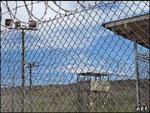 |
 |
| The rules technically allow executions at Guantanamo Bay |

|
UNITED STATES. US MILITARY ISSUES NEW EXECUTION REGULATIONS
January 23, 2006: the US Army has issued new regulations governing the death penalty, raising speculation that the military might be preparing for its first execution since 1961.
"This publication is a major revision," said the document issued January 17 and signed by Sandra Riley, administrative assistant to the secretary of the Army.
"This regulation establishes responsibilities and updates policy and procedures for carrying out a sentence of death as imposed by general courts-martial or military tribunals," the document said.
There are currently six men on military death row in Fort Leavenworth, Kansas. One, Dwight Loving, is believed to be the leading candidate for execution.
"We're worried these new regulations might be a sign they are getting ready for an execution," said David Elliot of the National Coalition to Abolish the Death Penalty.
Loving, an Army private stationed at Fort Hood, Texas, was convicted of murdering two taxicab drivers in 1988. The US Supreme Court upheld his sentence in 1996.
The United States Court of Appeals for the Armed Forces rejected his latest appeal last month. It is unclear what, if any, legal resources, he has left at his disposal. The execution would have to be approved by President George W. Bush to go ahead.
In the last military execution to take place, Army Pvt. John Bennett, convicted of the 1955 rape and attempted murder of an 11-year-old Austrian girl, was hanged at Fort Leavenworth on April 19, 1961.
Two servicemen were sentenced to death last year. Sgt. Hasan Akbar was convicted of killing two military officers in Kuwait in 2003 during the opening days of the US invasion of Iraq. A jury also sentenced Senior Airman Andrew Witt for stabbing to death his wife and another airman.
Most of the changes in the new regulations were technical, clarifying the role of various officers in the execution procedure. However, one change would make it possible for executions to take place at sites other than Fort Leavenworth.
"This new regulation appears to allow officials at appropriate levels with appropriate coordination to determine the location of an execution on a case-by-case basis," said Sheldon Smith, an Army public affairs specialist.
The move theoretically opened the way for foreign terrorism suspects held at Guantanamo Bay, Cuba, who might in the future be sentenced to death by military commissions, to be executed at the prison.
Currently, 10 Guantanamo Bay detainees have been charged with various offenses, but none of these are capital cases. (Sources: Reuters, 23/01/2006)
|

